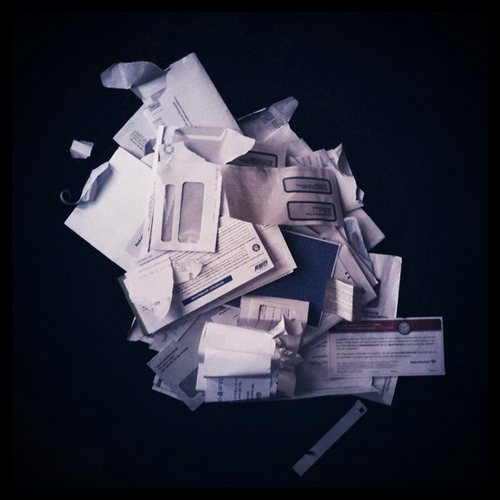Kitchen island zero
 [Photo by kowitz via Flicker]
[Photo by kowitz via Flicker]
I can’t get rid of paper. Some utility companies just refuse to offer e-bills. I get insurance statements and EOBs. Honestly, I still get all kinds of crap in my paper mailbox.
Since I was old enough to care what happened to mail after I opened it, I’ve had some kind of scheme for keeping up with it. And at the end of every scheme’s life cycle, I run into the same brick wall conclusion.
Filing cabinets are sideways trash cans.
Stuff goes in. It sits there for years. And it usually doesn’t come out until it’s time to dump it in a waste bin.
If you’re like me – and I’m going to be super presumptuous and say you are since you’re still reading – you’ve probably spent much more effort creating and maintaining paper filing systems than those systems have paid you back in efficiency and saved time.
I mean, seriously. How many times a year do you actually go to your paper file for information? I hardly ever do. But, I do sometimes need to get stuff.
Paper, effort, you
The effort spent filing things should be proportional to the frequency you access your files.
Wha? That’s just me trying to think of a quotable, smart way of saying this:
If you go to your paper file a lot, finding things quickly is valuable. If you go there a handful of times per year, it’s okay if you have to dig for a while each time. Make sense? Hope so.
Try this method on for size:
- Buy the biggest, deepest-pocketed accordion file folder you can find at your local office store.
- Label one of those crevasses with the current year.
Stop. Put the label maker away. Seriously… set it down, and Back. A. Way.
Breathe
Hey you, still with me? Cool. Don’t worry: next year, you can label the next crevasse in line.
If you’re used to thinking that a paper filing system isn’t worth a damn unless it has monthly folders, then this probably sounds like a cop out. It is. And that’s why it works.
If filing is easy, it happens. If it’s hard, paper forms windrows on your kitchen island. In fact, let’s just call this “kitchen island zero.” It’s inbox zero for your paper-based world.
When mail arrives, process the hell out of it. Make it gone:
- Shred junk
- Archive stuff you may need in the annual bucket
- Jot down tasks (todos) for actionable mail
Partitioning as a service
The paper tragedy in everyone’s life is different, so you may need some extra differentiation. Maybe you need one or two extra divisions. But I highly recommend partitioning your paper files no more frequently than annually.
Annual archives just work for me. I’ve found that I spend almost the same amount of time looking for a piece of paper in an aggregate annual bucket than I do looking through monthly folders. Why? Because half the time I don’t even remember what month I should be looking in anyway.
It’s sorta like having a bulging sidebar of email labels (tags) that you never use.
Just try it and see if you like it. Start simple. Add complexity only when needed (that proportional thing again).
Note: I will likely get a few emails about using a scanner to go totally paperless. I flirt with that workflow every so often, but never implement it for various reasons. If I do, you’ll hear from me about it.
